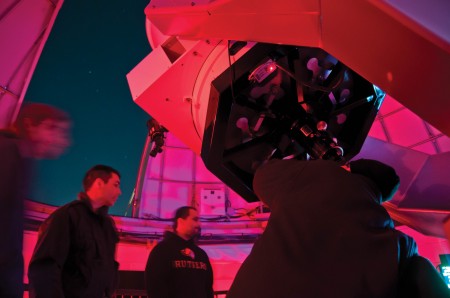Jupiter is 483.5 million miles away or four times as far from the Earth as the Earth is from the sun. There is a good chance most George Mason University students will never see it as more than a distant light in the night sky, barely discernible from a star. Harold Geller, a professor in the astronomy department, is helping to change that.
He hosted one of his ongoing astronomy observing sessions last Monday. These sessions give any student a chance to use Mason’s astronomy observatory tower atop Research I to better see and understand the universe.
Geller has been hosting the sessions at Mason since 1996, eight years before construction began on Research I. It wasn’t that long ago when he directed the students’ attention through telescopes much smaller than the one that he now uses.
It’s 9:00 p.m., an hour after the session begins, and the line coils down a narrow staircase leading up to the main telescope.
Jupiter was the focus of this session. The night was clear, and both the planet and its four Galilean moons, Io, Europa, Ganymede and Callisto, were visible. Outside, another line formed for a smaller telescope focused on the moon. While only 10 percent visible, the crags and craters along the moon’s surface were clear and sharp when seen through the telescope lenses.
As the night progressed, the view of Jupiter became obscured by the tree line; the telescope was readjusted for a view of Venus and, later, Mars. Those who stayed later into the evening were given a view of Messier 81, a spiral galaxy 12 million light-years from the Milky Way.
The Research I telescope has the largest diameter of any on-campus telescope on the east coast. According to Geller, the University of Virginia and University of Maryland both have larger ones, but neither observatory is on its respective campus.
Geller arrived at Mason in the ‘80s as a graduate student and swiftly thereafter began petitioning for the university to get its own telescope. According to many students at the observing session, it was a wise choice.
A diverse crowd was in attendance. Everyone from freshmen girls with newly earned sorority letters to older couples coming out from the city with their children all peered through the lenses into the night sky.
Junior government & international politics major Joseph Quarcoo, who is also a resident advisor, took his floor to the observing session.
“It’s great. You’re going to love it,” he said to his residents in the crowded Research I lobby. “I used to want to be an astronaut. Then stuff started blowing up, and I was much happier just looking at [space] from a distance.”
Erald Kolasi, a Ph.D. student studying theoretical astrophysics, weathered the cold to come see the session for the first time.
“I saw Jupiter. I’ve seen it before but never this large,” Kolasi said. “The whole thing was very interesting, I’ll definitely be coming back to see Venus and Mars.”
Geller cited his youth in New York and in particular trips to the Hayden Planetarium in the American Museum of Natural History as the source of his passion for astronomy. He intends to replicate his inspiration for another generation.







Comments